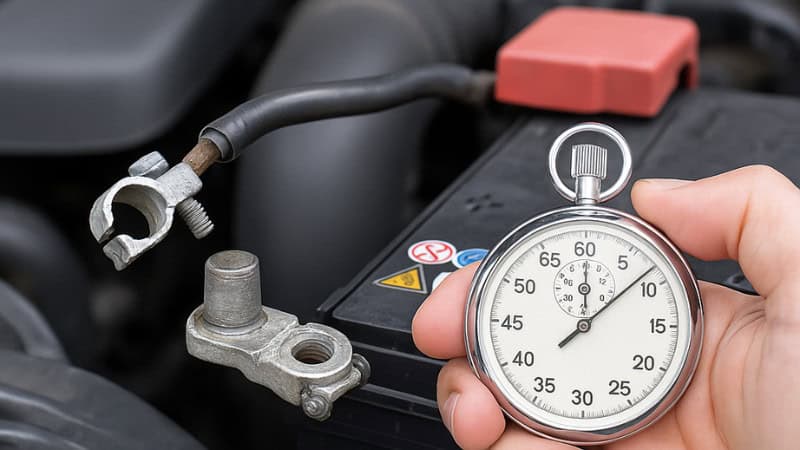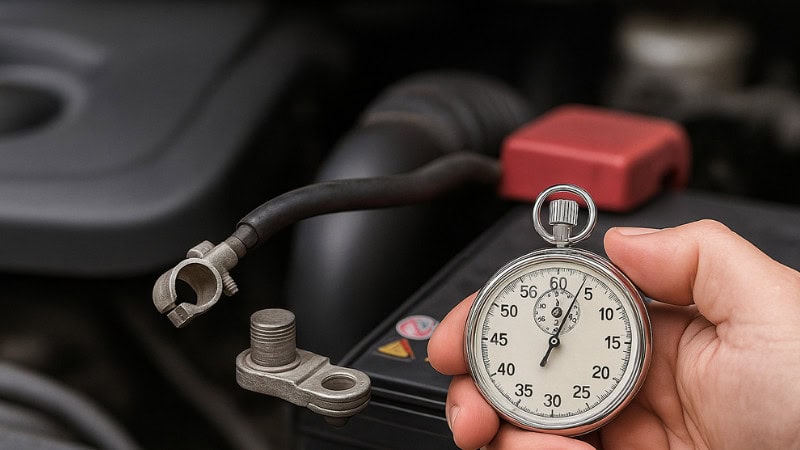Ever had that check-engine light pop up and hoped you could fix it with a quick battery disconnect? You’re not alone. Most drivers have tried it at least once — pull the negative cable, grab a coffee, hook it back up, and hope that annoying light disappears.
While it sounds simple, there’s actually some real science behind how long you should leave the battery disconnected and what happens when you do it.
In this guide, I’ll break it all down like I would in the shop — no fancy jargon, just straight talk from one mechanic to another.

What Happens When You Disconnect the Battery
Your car’s computer — officially called the ECU (Engine Control Unit) — is the brain that keeps everything running smoothly. It controls fuel delivery, ignition timing, idle speed, throttle response, and even how your transmission shifts.
When you disconnect the battery, you’re basically cutting power to that brain. It’s like pulling the plug on your laptop — it forgets its short-term memory.
Here’s what actually happens:
- Adaptive memory is wiped. The ECU stores “learned” data about your driving habits, idle, and fuel trims. Removing power erases that.
- Long-term fuel trims reset. The system forgets how much fuel to add or subtract for perfect combustion.
- Idle control relearns. After reconnecting, the car might idle high or rough for a bit while it relearns the correct air/fuel ratio.
- Diagnostic Trouble Codes (DTCs) — the check-engine light codes — may clear temporarily, depending on the fault.
But it’s not all good news. Disconnecting the battery also resets things like:
- Radio presets
- Clock settings
- Power window memory
- Transmission shift learning
- Radio security codes on some older vehicles
So yeah, it’s not exactly a magic reset button — but when used right, it can help clear temporary ECU glitches.
How Long to Leave the Battery Disconnected
The short answer: 10 to 15 minutes.
That’s usually enough time to let the car’s electrical systems fully discharge and reset the computer memory.
Here’s a step-by-step method every DIYer should follow:
- Turn off the ignition and remove the key. You don’t want any live circuits.
- Pop the hood and locate the battery.
- Disconnect the negative (–) cable first. This prevents short circuits if your wrench comes into contact with metal.
- Then, disconnect the positive (+) terminal.
- Wait at least 10 minutes. Some mechanics go up to 15 minutes to be safe.
- Optional trick: Press and hold the brake pedal for 10–15 seconds. That helps drain any leftover electricity stored in the ECU capacitors.
- Reconnect the positive cable first, then the negative.
- Tighten both terminals snugly — don’t overtighten.
- Start the engine and let it idle for approximately 10 minutes, allowing the ECU to relearn its parameters.
If you skip the waiting period, some residual power might still keep the ECU memory alive. That’s why 10–15 minutes (or using the brake-pedal trick) is important.
Different cars behave differently. For example:
- Toyota and Honda: Usually reset after 10–15 minutes.
- Ford and Chevy: Around 15 minutes works best.
- BMW, Mercedes, and newer SUVs: May retain codes even after 30 minutes — those often require a scanner reset.
When to Reset Your Car’s Computer
Disconnecting the battery isn’t something you do every day. But there are times when it makes sense:
- After replacing a sensor (like an O₂ sensor, MAF sensor, or throttle body).
- When fixing a check-engine issue and you want to clear stored data.
- After a dead-battery replacement to recalibrate adaptive learning.
- When the car idles roughly, shifts strangely, or hesitates after repairs.
Think of it like giving the car’s brain a “fresh start” after a fix. It allows the ECU to relearn its fuel, air, and throttle settings under new conditions.
But remember — if there’s an active problem (say, a bad catalytic converter or faulty ignition coil), disconnecting the battery won’t fix it. The check-engine light will just come back on once the system detects the fault again.
When NOT to Disconnect the Battery
Here’s where most people mess up. Modern cars (especially 2015 and newer) are packed with sensitive electronics. Cutting power the wrong way can trigger a whole new list of problems.
Avoid disconnecting the battery if:
- The car has ADAS systems (lane-assist, blind-spot monitoring, adaptive cruise) — those can lose calibration.
- You own a BMW, Mercedes, Audi, or newer Ford F-150 — some modules need a controlled power-down or reprogramming afterward.
- Your stereo or navigation system needs a security code after battery loss.
- You’re working on a hybrid or electric vehicle — those have high-voltage systems and require special procedures.
Instead, use a memory saver. It’s a small 9-volt or OBD plug-in device that keeps your computer memory alive while the battery is disconnected. Most shops (including mine) use them every time we change a battery.
What to Expect After Reconnecting the Battery
Once you reconnect and start your engine, a few things might feel off — don’t panic.
Here’s what to expect:
- The idle may fluctuate for a few minutes.
- The transmission might shift differently.
- The check-engine light may stay off for now, but could return if there’s still an issue.
- The clock and radio will need to be reset.
- You may lose radio presets and Bluetooth pairings.
During this relearn phase, drive gently for 15–20 minutes. Avoid flooring the gas or sudden braking.
Most ECUs have a “drive cycle” — a pattern of speeds and loads that helps the computer recheck sensors and confirm all systems are okay. After a few miles, your car should start running smoother as it relearns its ideal settings.
Alternative Ways to Reset Your Car’s Computer
Disconnecting the battery isn’t your only option. Here are three safer, sometimes faster, alternatives:
OBD-II Scanner Reset
Plug in a scan tool and select “Erase Codes” or “Clear DTCs.” This clears fault codes instantly without messing with radio memory or adaptive data.
Fuse Removal Reset
Some vehicles let you pull a specific fuse labeled “ECU,” “ECM,” or “EFI.” Wait 10 seconds, reinsert it, and the system resets.
Onboard Button Reset
Certain newer cars (like Nissan, Honda, and some GM models) have built-in keys or button sequences that trigger ECU resets. Check your owner’s manual or forums for your model.
If you work on cars often, investing in a simple OBD-II scanner is totally worth it. You can clear codes, check readiness monitors, and confirm if the reset actually worked.
Common Myths About Disconnecting the Battery
Let’s bust a few common myths that float around car forums and YouTube:
Myth #1: Disconnecting the battery always clears the check-engine light.
Not always true. It might clear temporary codes, but permanent or “hard” codes will reappear once the ECU runs another system check.
Myth #2: You can damage your ECU by disconnecting the battery.
Only if you do it wrong — like removing the positive terminal first or while the ignition’s on. Follow the proper order (negative off first, positive on first), and you’re fine.
Myth #3: Pulling the fuse for a few seconds does the same thing.
Nope. Most ECUs have capacitors that hold power for minutes. You need a full 10–15 minutes or a complete power drain.
Myth #4: Disconnecting the battery improves performance.
Sorry, no. It only resets adaptive learning — performance comes from fixing the root cause of any issues.
Tips from a Mechanic’s Toolbox
Here’s what I tell my customers and buddies:
- Always wear gloves and safety glasses when working with batteries.
- Keep a 10 mm wrench handy — that’s the size of most battery terminals.
- Don’t let the cables touch each other while disconnected.
- Use dielectric grease on terminals to prevent corrosion.
- Use a memory saver if your car has complex electronics.
- If the check-engine light comes back, scan the codes instead of guessing.
Key Takeaways
- Reset Time: Disconnect your car battery for 10–15 minutes to fully discharge the ECU and reset adaptive memory.
- Proper Order: Always remove the negative cable first and reconnect it last to avoid short circuits or voltage spikes.
- Relearning Period: After reconnecting, let the engine idle for about 10 minutes and drive gently for 15–20 minutes while the ECU relearns fuel trims and idle control.
- When to Use It: Ideal after sensor replacements, check-engine light fixes, or dead-battery swaps — but not a cure for mechanical or electrical faults.
- When Not to Use It: Avoid disconnecting the battery in modern or luxury vehicles (2015+) without a memory saver, as systems like ADAS and infotainment can lose calibration or data.
- Alternative Resets: Use an OBD-II scanner, ECU fuse removal, or onboard button sequence to reset safely without losing settings.
- Common Myths: Disconnecting the battery doesn’t guarantee clearing all codes, boosting performance, or damaging the ECU if done correctly.
- Pro Tip: Keep a basic OBD-II scanner in your glovebox — it’s the easiest way to read and clear trouble codes without guesswork.
Bottom Line: Disconnecting the battery can be a quick ECU reset trick, but it’s not a universal fix. Always address the underlying issue — your car’s computer is smarter than you think.
Frequently Asked Questions
Will disconnecting the battery clear all trouble codes?
Only temporary (soft) codes may clear. Permanent or “hard” codes stay stored in the ECU until the issue is fixed and cleared with a scan tool.
Can disconnecting the battery damage the ECU?
Not if done correctly. Always turn off the ignition, remove the negative cable first, and reconnect it last. Abruptly removing power with the key on can cause voltage spikes that harm modules.
Do I need to disconnect both terminals?
You technically only need to disconnect the negative cable, but removing both ensures no residual power sneaks through. Always disconnect the negative first, reconnect the positive first.
Why does my car run rough after reconnecting the battery?
The ECU needs to relearn idle and fuel trims. It’s normal for the car to idle high or feel sluggish for the first 10–20 minutes of driving.
Is there a faster or safer way to reset the ECU?
Yes — using an OBD-II scanner or a memory saver tool is quicker and won’t wipe your radio presets or trip newer modules.
Final Thoughts
Disconnecting your car battery can be a quick and effective way to reset your car’s computer — but it’s not a miracle cure.
If your check-engine light popped up for a random glitch, this trick can help. If it came on because of a real fault — bad sensor, misfire, or emission problem — it’ll just come right back.
For most cars, leaving the battery disconnected for 10 to 15 minutes does the job. Just remember to follow the correct procedure, stay safe, and don’t expect it to fix mechanical problems.
As I always say in the shop: “If the light comes back, your car’s trying to tell you something. Don’t ignore it.


